What Kind of Math Is on the Praxis Core Test?
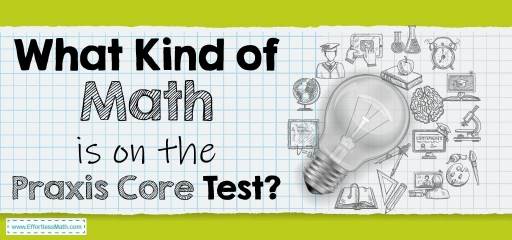
The Praxis Core is a standardized test that assesses students’ academic ability for admissions in teacher training programs in the United States. The test is administered by the Educational Testing Service (ETS). Many government licensing agencies, as well as colleges and universities, require certification of the Praxis Core test.
The Praxis Core test covers three topics: Math, Reading, Writing.
The math part of the Praxis Core test is 56 questions, some of which are multiple-choice and the rest are numeric entry questions. Test takers have 90 minutes to answer the Praxis Core Math test questions.
Test takers are not allowed to bring their calculators but are provided with an on-screen calculator.
Praxis Core Mathematics covers the following topics:
- Number and Quantity
- Algebra and Functions
- Geometry
- Data Interpretation, Statistics, and Probability
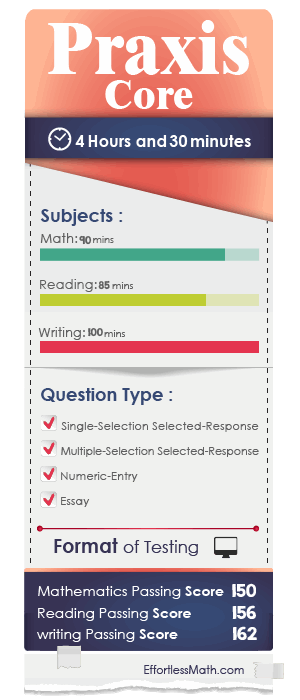
The Absolute Best Book to Ace the Praxis Core Math Test
Number and Quantity
In this section, you should be familiar with concepts such as proportions, ratios, addition, subtraction, multiplication, division, integers, radicals, and solving word problems. You must also have a thorough understanding of the order among fractions. You need to know how to represent a number in more than one way and what Properties of whole numbers are.
Algebra and Functions
The section on algebra and functions includes topics such as operation properties, linear equations, functions, graphing, and modeling. In other words, in this section, you need to master the manipulation of expressions and equations, solving linear and quadratic equations, solving problems of algebraic words.
Geometry
Geometrical figures, theorem circles, angles, area, volume, and geometric concepts are some of the items included in the geometry section of the Praxis Core Math test. To get the desired score in this section, you must be completely familiar with the characteristics of geometric shapes, similarities, and angle relationships.
Data Interpretation, Statistics, and Probability
Statistics and probabilities are an important part of the test where you need to have strong analysis and interpretation skills to succeed. Interpretation of quantitative information, understanding the relationships between data, and Determining mean, median, and mode are included in this section. Assigning a probability to an outcome is also one kind of question in this part of the test.
| math sections | topics | Percentage of questions | |
| #1 | Number and Quantity | Adding and Subtracting Integers, Multiplying and Dividing Integers, Order of Operations, Ordering Integers and Numbers, Integers and Absolute Value, Simplifying Ratios, Proportional Ratios, Similarity and Ratios, Percentage Calculations, Percent Problems, Discount, Tax and Tip, Percent of Increase and Decrease, Simple Interest, Simplifying Fractions, Adding and Subtracting Fractions, Multiplying and Dividing Fractions, Adding Mixed Numbers, Subtracting Mixed Numbers, Multiplying and Dividing Mixed Numbers, Dividing Mixed Numbers, Adding and Subtracting Decimals, Multiplying and Dividing Decimals, Comparing Decimals, Rounding Decimals, Factoring Numbers, Greatest, Common Factor, Least Common Multiple, Adding and Subtracting Integers, Multiplying and Dividing Integers, Order of Operations, Ordering Integers and Numbers, Integers and Absolute Value, Proportions, Ratios, and Percent | 36% |
| #2 | Algebra and Functions | Finding Slope, Graphing Lines Using Standard From, Graphing Lines Using Slope-Intercept Form, Writing Linear Equations, Graphing Linear Inequalities, Finding Midpoint, Finding Distance of Two Points, Simplifying Variable Expressions, Simplifying Polynomial Expressions, Translate Phrases into an Algebraic Statement, The Distributive Property, Evaluating One Variable Expression, Evaluating Two Variables Expressions, Combining like Terms, Function Notation, and calculation, Adding and Subtracting Functions, Multiplying and Dividing Functions, Composition of Functions, Multiplication Property of Exponents, Division Property of Exponents, Zero and Negative Exponents, Powers of Products and Quotients, Negative Exponents and Negative Bases, Scientific Notation, Radicals, Polynomials | 20% |
| #3 | Geometry | Pythagorean Theorem, Triangles, Polygons, Trapezoids, Circles, Cubes, Rectangular Prism, Cylinder | 12% |
| #4 | Data Interpretation, Statistics, and Probability | Mean, Median, Mode, and Range, Histograms, Pie Graph, Probability Problems, Combinations and Permutations | 32% |
Best Praxis Core Math Prep Resource for 2022
Complete List of Praxis Core Math Topics
Fractions and Decimals
- Simplifying Fractions
- Adding and Subtracting Fractions
- Multiplying and Dividing Fractions
- Adding Mixed Numbers
- Subtracting Mixed Numbers
- Multiplying Mixed Numbers
- Dividing Mixed Numbers
- Adding and Subtracting Decimals
- Multiplying and Dividing Decimals
- Comparing Decimals
- Rounding Decimals
- Factoring Numbers
- Greatest Common Factor
- Least Common Multiple
Real Numbers and Integers
- Adding and Subtracting Integers
- Multiplying and Dividing Integers
- Order of Operations
- Ordering Integers and Numbers
- Integers and Absolute Value
Proportions, Ratios, and Percent
- Simplifying Ratios
- Proportional Ratios
- Similarity and Ratios
- Percentage Calculations
- Percent Problems
- Discount, Tax and Tip
- Percent of Increase and Decrease
- Simple Interest
Algebraic Expressions
- Simplifying Variable Expressions
- Simplifying Polynomial Expressions
- Translate Phrases into an Algebraic Statement
- The Distributive Property
- Evaluating One Variable Expressions
- Evaluating Two Variables Expressions
- Combining like Terms
Equations and Inequalities
- One-Step Equations
- Multi-Step Equations
- Graphing Single–Variable Inequalities
- One-Step Inequalities
- Multi-Step Inequalities
- Systems of Equations
Linear Functions
- Finding Slope
- Graphing Lines Using Standard Form
- Graphing Lines Using Slope-Intercept Form
- Writing Linear Equations
- Graphing Linear Inequalities
- Finding Midpoint
- Finding Distance of Two Points
Exponents and Radicals
- Multiplication Property of Exponents
- Division Property of Exponents
- Zero and Negative Exponents
- Powers of Products and Quotients
- Negative Exponents and Negative Bases
- Scientific Notation
- Radicals
Polynomials
- Writing Polynomials in Standard Form
- Simplifying Polynomials
- Adding and Subtracting Polynomials
- Multiplying Monomials
- Multiplying and Dividing Monomials
- Multiplying a Polynomial and a Monomial
- Multiplying Binomials
- Factoring Trinomials
- Operations with Polynomials
Geometry and Solid Figures
Statistics and Probability
Functions
- Function Notation
- Adding and Subtracting Functions
- Multiplying and Dividing Functions
- Composition of Functions
FAQs:
Is the Praxis Core Math test hard?
Praxis Core test questions are usually much easier than the SAT and ACT questions.
How do I study for the Praxis Core Math?
How you prepare for the Praxis Core Math test is very important. You can use good prep books to prepare well for the Praxis Core Math test. You can also use online practice tests for further practice after studying the Praxis Core exam courses.
How many times can you take the Praxis test?
You can take the Praxis Core test once every 21 days.
Looking for the best resource to help you succeed on the Praxis Core Math test?
The Best Books to Ace the Praxis Core Math Test
Related to This Article
More math articles
- 3rd Grade Georgia Milestones Assessment System Math Practice Test Questions
- Top 10 4th Grade FSA Math Practice Questions
- Even or Odd Numbers
- How to Show the Relation in the Coordinate Plane
- Algebra Puzzle – Challenge 52
- What is the Highest ASVAB Score?
- 4th Grade North Carolina End-of-Grade Math Worksheets: FREE & Printable
- 10 Most Common ATI TEAS 7 Math Questions
- 5 Best Algebra 2 Books for High School Students
- 4th Grade NHSAS Math Worksheets: FREE & Printable
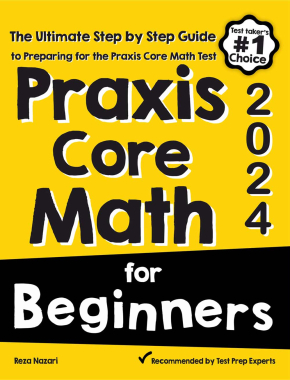
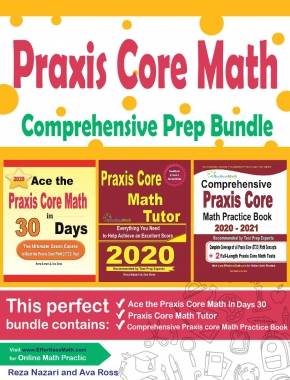
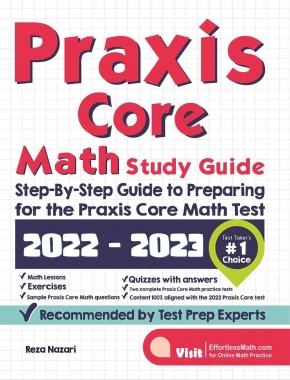
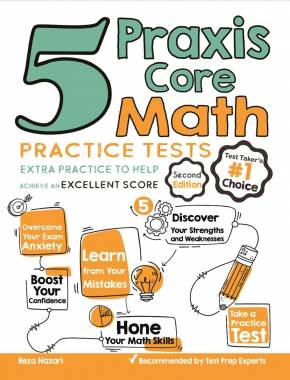
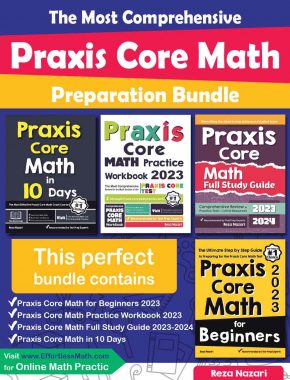
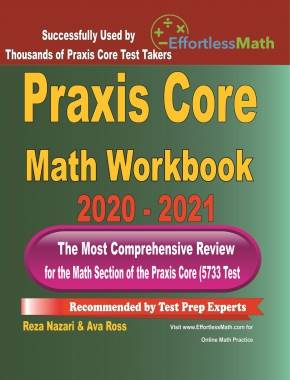
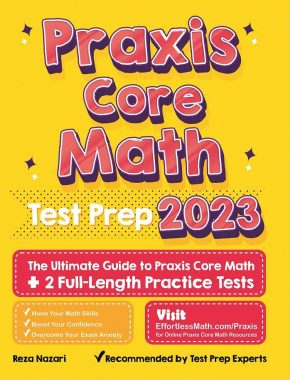
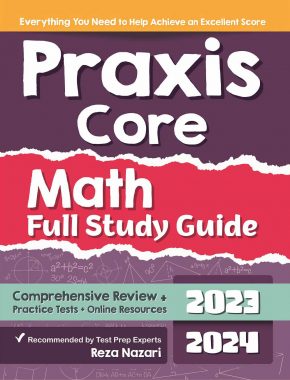
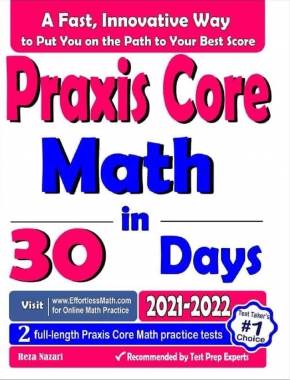
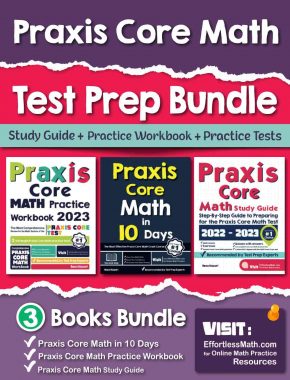
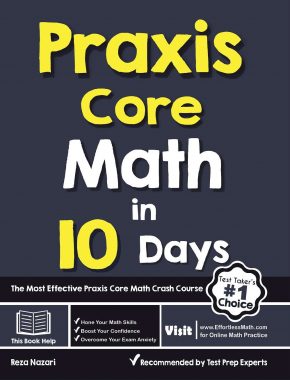
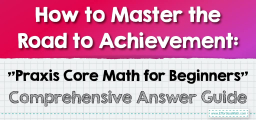
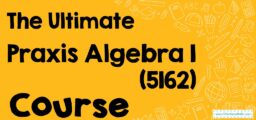






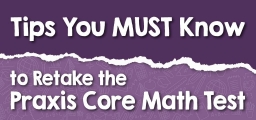

What people say about "What Kind of Math Is on the Praxis Core Test? - Effortless Math: We Help Students Learn to LOVE Mathematics"?
No one replied yet.